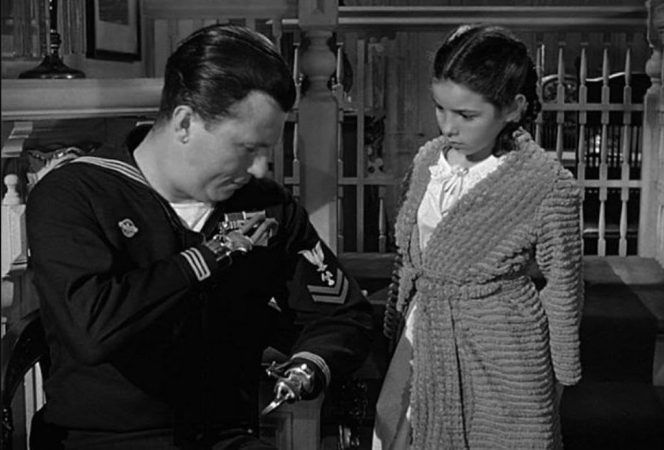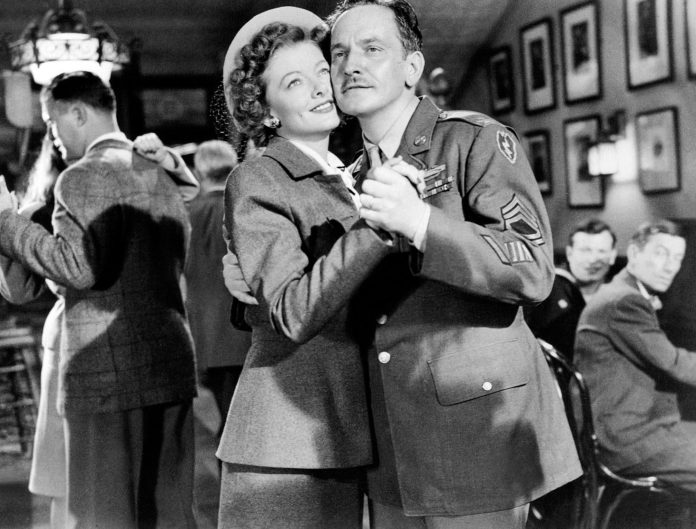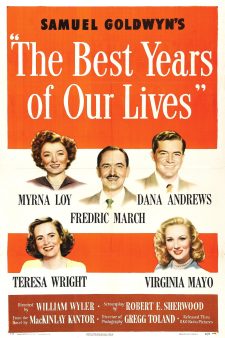Estimated reading time: 4 minutes
Table of contents
A Veteran’s Perspective on War Films
As a Vietnam-era Army veteran, I have long admired what our uniformed forces have faced in times of war. There have been numerous war-inspired films, particularly those dealing with World War II. Many of these movies have focused on the horrors of combat, often depicting bloody scenes of death and destruction. One noteworthy exception to this cinematic approach is the nearly 80-year-old Oscar winner, The Best Years of Our Lives. This legendary collaboration between director William Wyler, screenwriter Robert E. Sherwood, and producer Samuel Goldwyn tackles the issue of how veterans handle their post-war lives.
The Journey Home: Three Veterans Meet
The Best Years of Our Lives begins at the very end of WWII as three servicemen meet on a flight back home to Boone City: Air Force bombardier Captain Fred Derry (Dana Andrews), Army Sergeant Al Stephenson (Frederic March), and Navy Petty Officer Homer Parrish (Harold Russell). As the men discuss their lives and what they will be returning to, we get little snippets of their pre-war lives. Fred had married a blonde beauty, Marie (Virginia Mayo), just weeks before he went overseas. Al left behind his lucrative banking job and his family: wife Milly (Myrna Loy), daughter Peggy (Teresa Wright), and son Rob (Michael Hall). Homer is wearing a pair of prosthetic claws in place of the hands he lost in an explosion and eagerly awaits a reunion with his young girlfriend and next-door neighbor, Wilma Cameron (Cathy O’Donnell).

Struggles with Reintegration
The storyline follows these three men as they attempt to readjust to post-war civilian life. Fred finally tracks down Marie, who is working in a nightclub and is less than thrilled that he will be assuming a minimum-wage job at the soda shop where he worked before being deployed. Fred becomes infatuated with young Peggy, whom he met on his first day back. Ultimately, his marriage hits the rocks and rapidly goes under. Al has acquired an obvious drinking problem that could undermine his job as a loans officer at the bank, which rehired him with a significant promotion and salary raise. Homer has trouble accepting his status as a handicapped man, although his family and girlfriend do not see him that way.
Interwoven Lives and Healing
The inherent genius of this film lies in how these stories interweave into a compelling narrative about men from very different backgrounds who must now deal with their war-acquired demons. Fred still suffers from PTSD flashbacks that decrease after he connects with Peggy. Al still needs to find occasional comfort in the bottle but is succeeding in his new bank job. Homer gradually accepts the loss of his hands as he prepares to wed the love of his life.
A Timeless, Heartfelt Recommendation
Of all the many WWII movies, The Best Years of Our Lives remains one of the most heartfelt, down-to-earth accounts of the challenges many veterans negotiated after the war in which they fought had ended. With a dream cast and a moving story that will never grow old, this film readily receives my highest recommendation as an ideal Memorial Day selection—or really for any other day of the year.
The Best Years of Our Lives had its US premiere in NY, New York, November 21, 1946
Details
- Rating Certificate: Approved
- Studios & Distributors: Samuel Goldwyn Productions | RKO Radio Picture
- Director: William Wyler
- Written By: Robert E. Sherwood
- Country: USA
- Language: English
- Run Time: 172 Mins.
- Aspect Ratio: 1.85:1
- Release Date: 21 November 1946


